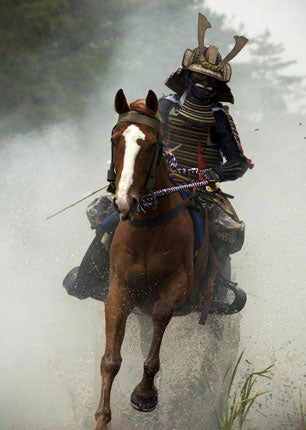Samurai warriors examined by Japanese and British scientists

Gruesome evidence of medieval Japanese Samurai warriors being decapitated, so that their heads could be taken as trophies by their enemies, is being examined by Japanese and British scientists.
In a bid to fully understand the nature of warfare in medieval Japan, Dr. Michael Wysocki, a specialist in forensic anthropology at the University of Central Lancashire, and Japanese scientists from Santa Marianna University, School of Medicine, near Tokyo, have been examining battle and decapitation trauma suffered by Samurai warriors in a 14th century Japanese civil war.
“The skeletal material is of huge importance in helping to understand the nature of warfare in medieval Japan,” said Dr. Wysocki of the University’s School of Forensic and Investigative Sciences.
The detailed examination of the skeletal remains – revealed in a special Channel 4 documentary, tomorrow evening – has yielded crucial new information on sword and arrow wounds, fighting styles, ritualized coup de grace death blows and the practice of taking heads as battle trophies.
The Samurai skeletons come from the ancient Japanese city of Kamakura where a key battle took place in 1333, in which literally thousands died. At the end of the battle, the remaining Samurai on the defeated side all committed ritual suicide. It’s the largest such event known from Japanese history.
The battle of Kamakura, 30 miles south-south-west of modern Tokyo, was one of the most important events in Japanese history – a historical watershed that, in part, determined the political and social character of much of the country’s subsequent history.
The event helped transform Japan by inaugurating a long era of civil conflict and political and military instability and de-centralization.
Prior to 1333, Kamakura, the city where the battle took place, had been the administrative headquarters of the Japanese government of that period, the so-called Shogunate, which had, for the previous 140 years, succeeded in greatly reducing the political power of the Japanese emperor.
But then, in 1333 the supporters of the emperor rose-up and defeated the Shogun’s administration – and, by doing so, undermined for many decades Japan’s capacity to sustain stable government .
“The sheer volume of human remains and the extraordinary historical background makes Kamakura one of the most significant sites in the world from a battlefield and conflict perspective,” said Dr. Wysocki.
Very large numbers of fighters had been beheaded – many almost certainly as a result of trophy-taking practises by the emperor’s forces. In 14th century Japan, victorious warriors often only received rewards for success in war if they proved their achievements by presenting the decapitated heads of enemy warriors to their leaders.
Decapitated enemy heads thus became a bizarre currency of a military accounting process which rewarded victors only if they could furnish proof of their military accomplishments.
One of the skeletons, looked at in detail by Dr. Wysocki and featured in this Sunday’s Channel 4 documentary, is a probable female samurai. In the 13th and early 14th century, many Japanese women, under the Shogun’s rule, were relatively emancipated, enjoying virtually the same property rights as men, the right to inherit property and were, like men, required to perform military guard duties.
Investigations into the Kamakura skeletal material – excavated over many decades - is continuing in Japan as part of efforts to shed greater light on what happened in the run up to 1333, during the battle and its aftermath.
Samurai: Back from the Dead, Channel 4, 8pm, Sunday, 18th September
Join our commenting forum
Join thought-provoking conversations, follow other Independent readers and see their replies
Comments